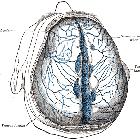normale zerebrale Verkalkungen
Normal intracranial calcifications can be defined as all age-related physiologic and neurodegenerative calcifications that are unaccompanied by any evidence of disease and have no demonstrable pathological cause.
The most common sites include:
- pineal gland
- seen in 2/3 of the adult population and increases with age
- calcification over 1 cm in diameter or under nine years old may be suggestive of a neoplasm
- habenula
- it has a central role in the regulation of the limbic system and is often calcified with a curvilinear pattern a few millimeters anterior to the pineal body in 15% of the adult population
- choroid plexus
- a very common finding, usually in the atrial portions of the lateral ventricles (choroid glomus)
- calcification in the third or fourth ventricle or patients less than nine years of age is uncommon
- basal ganglia
- are usually incidental idiopathic findings that have an incidence of ~1% (range 0.3-1.5%) and increases with age
- usually, demonstrate a faint punctuate or a coarse conglomerated symmetrical calcification pattern
- see basal ganglia calcification for specific differential
- falx, dura mater or tentorium cerebelli
- occur in ~10% of the elderly population
- dural and tentorial calcifications are usually seen in a laminar pattern and can occur anywhere within the cranium
- petroclinoid ligaments
- common age-related degeneration sites and usually have laminar or mildly nodular patterns
- superior sagittal sinus
- common age-related degeneration sites and usually have laminar or mildly nodular patterns
- dentate nuclei of cerebellum
- hippocampus
See also
Siehe auch:
- zerebrale Verkalkungen
- intrakranielle Verkalkungen
- Basalganglienverkalkungen
- Sinus sagittalis superior
- Glandula pinealis
- habenula
- globus pallidus calcification
- verkalkte Meningen
- Ligamentum petroclinoideum
- Verkalkungen Plexus choroideus
und weiter:
 Assoziationen und Differentialdiagnosen zu normale intrakranielle Verkalkungen:
Assoziationen und Differentialdiagnosen zu normale intrakranielle Verkalkungen:

















